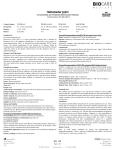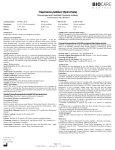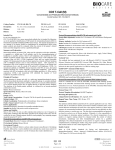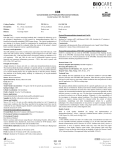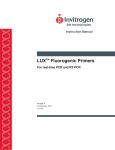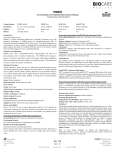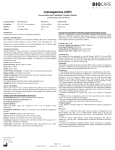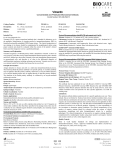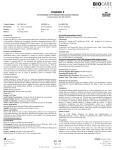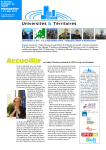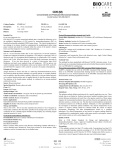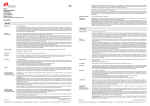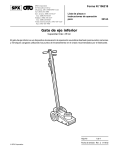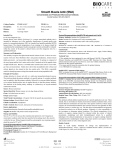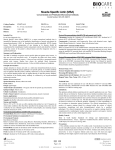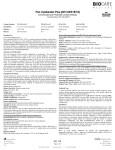Download Data Sheet
Transcript
CD34 Concentrated and Prediluted Monoclonal Antibody Control Number: 901-084-032415 Catalog Number: CM 084 A, B, C PM 084 AA, H IP 084 G10 OAI 084 T60 Description: 0.1, 0.5, 1.0 ml, concentrated 6.0, 25 ml, prediluted 10 ml, prediluted 60 tests, prediluted Dilution: 1:50-1:100 Ready-to-use Ready-to-use Ready-to-use Diluent: Da Vinci Green N/A N/A N/A Intended Use: For In Vitro Diagnostic Use CD34 [QBEnd/10] is a mouse monoclonal antibody that is intended for laboratory use in the qualitative identification of CD34 protein by immunohistochemistry (IHC) in formalin-fixed paraffin-embedded (FFPE) human tissues. The clinical interpretation of any staining or its absence should be complemented by morphological studies using proper controls and should be evaluated within the context of the patient’s clinical history and other diagnostic tests by a qualified pathologist. Summary and Explanation: CD34 recognizes a single chain transmembrane glycoprotein of 110 kDa. This antigen is selectively expressed in human lymphoid and myeloid hematopoietic progenitor cells. The antibody to CD34 also reacts with vascular endothelial cells in normal tissues, and in benign and malignant proliferations. The utility of CD34 has value in the studies of benign and malignant vascular tumors as well as characterization of acute leukemia in bone marrow. CD34 has been used to measure angiogenesis in many types of tumors, which reportedly predicts tumor recurrence. It is also used to differentiate dermatofibrosarcoma protuberans from fibrous histiocytoma. Principle of Procedure: Antigen detection in tissues and cells is a multi-step immunohistochemical process. The initial step binds the primary antibody to its specific epitope. A secondary antibody may be applied to bind the primary antibody, followed by an enzyme labeled polymer; or an enzyme labeled polymer may be applied directly to bind the primary antibody. The detection of the bound primary antibody is evidenced by an enzyme-mediated colorimetric reaction. Source: Mouse monoclonal Species Reactivity: Human; others not tested Clone: QBEnd/10 Isotype: IgG1 Total Protein Concentration: ~10 mg/ml. Call for lot specific Ig concentration. Epitope/Antigen: CD34 Cellular Localization: Cell Surface and cytoplasmic Positive Tissue Control: Tonsil, skin or angiosarcoma Known Applications: Immunohistochemistry (formalin-fixed paraffin-embedded tissues) Supplied As: Buffer with protein carrier and preservative Storage and Stability: Store at 2ºC to 8ºC. Do not use after expiration date printed on vial. If reagents are stored under conditions other than those specified in the package insert, they must be verified by the user. Diluted reagents should be used promptly; any remaining reagent should be stored at 2ºC to 8ºC. Protocol Recommendations (intelliPATH and manual use): Peroxide Block: Block for 5 minutes with Biocare's Peroxidazed 1. Pretreatment Solution (recommended): Reveal Pretreatment Protocol: Heat Retrieval Method: Retrieve sections under pressure using Biocare's Decloaking Chamber, followed by a wash in distilled water; alternatively, steam tissue sections for 45-60 minutes. Allow solution to cool for 10 minutes then wash in distilled water. ISO 9001&13485 CERTIFIED Protocol Recommendations (intelliPATH and manual use) Cont'd: Protein Block (Optional): Incubate for 5-10 minutes at RT with Biocare's Background Punisher. Primary Antibody: Incubate for 30 minutes at RT. Probe: Incubate for 10 minutes at RT with a secondary probe. Polymer: Incubate for 10-20 minutes at RT with a tertiary polymer. Chromogen: Incubate for 5 minutes at RT with Biocare's DAB - OR - Incubate for 5-7 minutes at RT with Biocare's Warp Red. Counterstain: Counterstain with hematoxylin. Rinse with deionized water. Apply Tacha's Bluing Solution for 1 minute. Rinse with deionized water. Technical Note: This antibody has been optimized for use with Biocare's MACH 4 Universal HRPPolymer Detection and intelliPATH Universal HRP Detection Kit. Other Biocare polymer detection kits may be used; however, users must validate incubation times and protocols for their specific application. Use TBS for washing steps. intelliPATH™ Automated Slide Stainer: IP084 is intended for use on the intelliPATH™ Automated Slide Stainer. Refer to the intelliPATH Automated Slide Stainer manual for specific instructions on its use. When using the intelliPATH, peroxide block with intelliPATH Peroxidase Blocking Reagent (IPB5000) may be performed following heat retrieval. Protocol Recommendations (ONCORE Automated Slide Staining System): OAI084 is intended for use with the ONCORE Automated Slide Staining System. Refer to the ONCORE Automated Slide Staining System User Manual for specific instructions on its use. Protocol parameters in the ONCORE Automated Slide Stainer Protocol Editor should be programmed as follows: Protocol Name: CD34 Protocol Template (Description): Ms HRP Template 1 Dewaxing (DS Option): DS2 Antigen Retrieval (AR Option): AR1, high pH; 101°C Reagent Name, Time, Temp.: CD34, 30 min., 25°C Limitations: The optimum antibody dilution and protocols for a specific application can vary. These include, but are not limited to: fixation, heat-retrieval method, incubation times, tissue section thickness and detection kit used. Due to the superior sensitivity of these unique reagents, the recommended incubation times and titers listed are not applicable to other detection systems, as results may vary. The data sheet recommendations and protocols are based on exclusive use of Biocare products. Ultimately, it is the responsibility of the investigator to determine optimal conditions. The clinical interpretation of any positive or negative staining should be evaluated within the context of clinical presentation, morphology and other histopathological criteria by a qualified pathologist. The clinical interpretation of any positive or negative staining should be complemented by morphological studies using proper positive and negative internal and external controls as well as other diagnostic tests. Quality Control: Refer to CLSI Quality Standards for Design and Implementation of Immunohistochemistry Assays; Approved Guideline-Second edition (I/LA28-A2) CLSI Wayne, PA USA (www.clsi.org). 2011. Page 1 of 2 CD34 Concentrated and Prediluted Monoclonal Antibody Control Number: 901-084-032415 Precautions: 1. This antibody contains less than 0.1% sodium azide. Concentrations less than 0.1% are not reportable hazardous materials according to U.S. 29 CFR 1910.1200, OSHA Hazard communication and EC Directive 91/155/EC. Sodium azide (NaN3) used as a preservative is toxic if ingested. Sodium azide may react with lead and copper plumbing to form highly explosive metal azides. Upon disposal, flush with large volumes of water to prevent azide build-up in plumbing. (Center for Disease Control, 1976, National Institute of Occupational Safety and Health, 1976) (7) 2. Specimens, before and after fixation, and all materials exposed to them should be handled as if capable of transmitting infection and disposed of with proper precautions. Never pipette reagents by mouth and avoid contacting the skin and mucous membranes with reagents and specimens. If reagents or specimens come in contact with sensitive areas, wash with copious amounts of water. (8) 3. Microbial contamination of reagents may result in an increase in nonspecific staining. 4. Incubation times or temperatures other than those specified may give erroneous results. The user must validate any such change. 5. Do not use reagent after the expiration date printed on the vial. 6. The SDS is available upon request and is located at http://biocare.net/. ISO 9001&13485 CERTIFIED Troubleshooting: Follow the antibody specific protocol recommendations according to data sheet provided. If atypical results occur, contact Biocare's Technical Support at 1-800-542-2002. References: 1. Rimsza LM, et al. The presence of CD34+ cell clusters predicts impending relapse in children with acute lymphoblastic leukemia receiving maintenance chemotherapy. Am J Clin Pathol. 1998 Sep;110(3):313-20. 2. Bettencourt MC, et al. CD34 immunohistochemical assessment of angiogenesis as a prognostic marker for prostate cancer recurrence after radical prostatectomy. J Urol. 1998 Aug;160(2):459-65. 3. Sauter B, F et al. Immunoelectron microscopic characterization of human dermal lymphatic microvascular endothelial cells. Differential expression of CD31, CD34, and type IV collagen with lymphatic endothelial cells vs blood capillary endothelial cells in normal human skin, lymphangioma, and hemangioma in situ. J Histochem Cytochem. 1998 Feb;46(2):165-76. 4. Diaz-Cascajo C, et al. Dermatofibrosarcoma protuberans with fibrosarcomatous areas: a clinico-pathologic and immunohistochemic study in four cases. Am J Dermatopathol. 1997 Dec;19(6):562-7. 5. Yamane H, et al. Small cell lung cancer can express CD34 antigen. Anticancer Res. 1997 Sep;17(5A):3627-32. 6. Raspadori D, et al. Incidence and prognostic relevance of CD34 expression in acute myeloblastic leukemia: analysis of 14 cases. Leuk Res. 1997 Jul;21(7):603-7. 7. Center for Disease Control Manual. Guide: Safety Management, NO. CDC-22, Atlanta, GA. April 30, 1976 "Decontamination of Laboratory Sink Drains to Remove Azide Salts." 8. Clinical and Laboratory Standards Institute (CLSI). Protection of Laboratory Workers from Occupationally Acquired Infections; Approved Guideline-Fourth Edition CLSI document M29-A4 Wayne, PA 2014. Page 2 of 2


![Progesterone Receptor (PR) [16]](http://vs1.manualzilla.com/store/data/005703733_1-5d4a6a4c070c4aacc906912b3410a27a-150x150.png)
